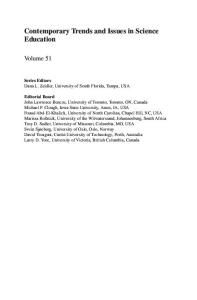Scientific Inquiry in Mathematics - Theory and Practice A STEM Persp
This valuable resource provides an overview of recent research and strategies in developing and applying modelling to promote practice-based research in STEM education. In doing so, it bridges barriers across academic disciplines by suggesting activities
- PDF / 4,045,873 Bytes
- 142 Pages / 439.43 x 683.15 pts Page_size
- 2 Downloads / 341 Views
Scientific Inquiry in Mathematics - Theory and Practice A STEM Perspective
Scientific Inquiry in Mathematics - Theory and Practice
Andrzej Sokolowski
Scientific Inquiry in Mathematics - Theory and Practice A STEM Perspective
Andrzej Sokolowski Division of Mathematics and Science Lone Star College Tomball, TX, USA
ISBN 978-3-319-89523-9 ISBN 978-3-319-89524-6 https://doi.org/10.1007/978-3-319-89524-6
(eBook)
Library of Congress Control Number: 2018938186 © Springer International Publishing AG, part of Springer Nature 2018 This work is subject to copyright. All rights are reserved by the Publisher, whether the whole or part of the material is concerned, specifically the rights of translation, reprinting, reuse of illustrations, recitation, broadcasting, reproduction on microfilms or in any other physical way, and transmission or information storage and retrieval, electronic adaptation, computer software, or by similar or dissimilar methodology now known or hereafter developed. The use of general descriptive names, registered names, trademarks, service marks, etc. in this publication does not imply, even in the absence of a specific statement, that such names are exempt from the relevant protective laws and regulations and therefore free for general use. The publisher, the authors and the editors are safe to assume that the advice and information in this book are believed to be true and accurate at the date of publication. Neither the publisher nor the authors or the editors give a warranty, express or implied, with respect to the material contained herein or for any errors or omissions that may have been made. The publisher remains neutral with regard to jurisdictional claims in published maps and institutional affiliations. Printed on acid-free paper This Springer imprint is published by the registered company Springer International Publishing AG part of Springer Nature. The registered company address is: Gewerbestrasse 11, 6330 Cham, Switzerland
Preface
Albert Einstein wondered, “How can it be that mathematics, being after all a product of human thought which is independent of experience, is so admirably appropriate to the objects of reality?”1 January 27, 1921, address to the Prussian Academy of Science, Berlin.
Objective of the Book A gap between problem-solving in mathematics and scientific inquiry in science is beyond controversy. Attempts to elevate the gap are made and this book aspires to be one of such attempts. The book is to promote transdisciplinary STEM learning experiences that support the thesis that exploring mathematics concepts using scientific methods can help to merge the two methodologies. Furthermore, it is hoped that such learning settings are to develop students’ mathematical reasoning skills and serve as a means to improve students’ STEM readiness. The objective of this book is to propose a theoretical framework and multidisciplinary modeling activities of what STEM learning in the twenty-first century classroom might look like. This book draws on a diverse literature from international
Data Loading...











